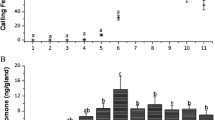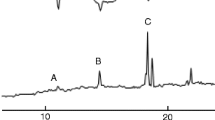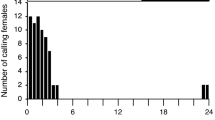Abstract
The sex pheromone of Lonomia obliqua Walker (Lepidoptera: Saturniidae) was studied in the laboratory. All female calling occurred during the scotophase. Most females (70.6%) called first within 24 hr of eclosion. Calling varied with age of female, with older (5- to 6-day-old) females calling earlier in the scotophase and for longer durations than younger (0- to 1-day-old) females. The sex pheromone gland of 1- to 3-day-old virgin females was extracted during the calling peak. A Y-olfactometer bioassay showed significant attraction of males to a filter paper containing the female gland extract. Gas chromatographic-electroantennogram detection (GC-EAD) analysis of the extract indicated the presence of at least two possible pheromone components. Gas chromatographic-mass spectrometric analysis of the major GC-EAD-active peak indicated a hexadecenyl acetate; chemical derivatization indicated Δ11 unsaturation. Synthetic samples of (E)- and (Z)-11-hexadecenyl acetate were obtained by coupling 10-bromo-1-decanol and 1-hexyne, utilizing lithium chemistry. The comparison of the retention time of dimethyl disulfide derivatives of the natural compound, to those of synthetic chemicals, confirmed the natural compound as (E)-11-hexadecenyl acetate. The minor component was identified as the related alcohol, (E)-11-hexadecenol. The ratio of the two components in female extract was 100:35. Preliminary tests of males in a Y-olfactometer showed that their response to a mixture of the two compounds was not significantly different from that to gland extract.





Similar content being viewed by others
References
Attygalle, A. B. 1998. Microchemical techniques, pp. 207–294, in J. G. Millar and K. F. Haynes (eds.). Methods in Chemical Ecology V1. Kluwer Academic Publishers, Norwell, Massachusetts.
Bestmann, H. J., Attygalle, A. B., Schwarz, J., Wolfgang, G., Vostrowisky, O. and Tomida, I. 1989. Pheromones identification and synthesis of female sex pheromone of eri-silkworm, Samia cynthia ricini (Lepidoptera: Saturniidae). Tetrahedron Lett. 22:2911–2914.
Caserio, M. C., Fisher, C. L. and Kim, J. K. 1985. Boron trifluoride catalyzed addition of disulfide to alkenes. J. Org. Chem. 50:4390–4393.
Crawley, M. 2002. Statistical Computing, An Introduction to Data Analysis Using S-Plus. John Wiley & Sons, Ltd. 761 p.
Crawley, M. 2005. Statistics. An Introduction to Using R. John Wiley & Sons, Ltd. 327 p.
Duarte, A. C., Caovilla, A. J., Lorini, I., Lorini, D., Mantovani, G., Sumida, J., Manfre, P. C., Silveira, R. C. and Moura, S. P. 1990. Insuficiência renal aguda por acidentes com lagartas. J. Bras. Nefrol. 12:184–187.
Fornés, L. and Hernández, J. V. 2000. Algunos aspectos de la biología de Hylesia metabus (Cramer 1775) (Lepidoptera: Saturniidae). Bol. Entomol. Venez. 15:127–145.
Henderson, H. E., Warren, O. P. H., Augustyn, B. V., Burger, D. F., Schneider, A., Boshoff, P. R., Spies, H. S. C. and Geertsema, H. 1973. Isolation and structure of the sex-pheromone of the moth. Nudaurelia cytherea cytherea. J. Insect Physiol. 19:1257–1264.
Kang, S.-K. and Park, S.-K. 1988. A stereoselective synthesis of (Z, Z)-3,13-octadecadien-1-yl acetate, and its (E, Z)-isomer, the sex pheromone of the cherry tree borer, Synanthedon hector Butler. Bull. Korean Chem. Soc. 9:149–152.
Kochansky, J. P., Tette, J., Taschenberg, E. F., Cardé, R. T., Kaissling, K. E. and Roelofs, W. L. 1975. Sex pheromone of the Antheraea polyphemus. J. Insect Physiol. 21:1977–1983.
Leal, W. S., Mochizuki, F., Wakamura, S. and Yasuda, T. 1992. Eletroantennografic detection of Anomala cuprea sex pheromone. Appl. Entomol. Zool. 27:289–291.
Leal, W. S., Kawamura, F. and Ono, M. 1994. The scarab beetle Anomala albopilosa sakishimana utilizes the same sex pheromone blend as a closely related and geographically isolated species, Anomala cuprea. J. Chem. Ecol. 20:1667–1676.
Lorini, L. M. 1999. A taturana, aspectos biológicos e morfológicos da Lonomia obliqua. Ediupf, Passo Fundo, p. 67.
Lorini, L. M. and Corseuil, É. 2001. Aspectos morfológicos de Lonomia obliqua Walker, 1855 (Lepidoptera: Saturniidae) em laboratório. Neotrop. Entomol. 30:373–378.
Lorini, L. M., Rebelato, G. S. and Bonatti, J. 2004. Reproductive parameters of Lonomia obliqua Walker, 1855, (Lepidoptera: Saturniidae) in laboratory. Braz. Arch. Biol. Technol. 47:575–577.
McElfresh, J. S. and Millar, J. G. 1999a. Sex pheromone of the common sheep moth Hemileuca eglanterina, from the San Gabriel Mountains of California. J. Chem. Ecol. 25:687–709.
McElfresh, J. S. and Millar, J. G. 1999b. Sex attractant pheromone of saturniid moth Coloradia velda. J. Chem. Ecol. 25:1067–1078.
McElfresh, J. S. and Millar, J. G. 1999c. Sex pheromone of Nuttall’s sheep moth Hemileuca nuttalli from The Eastern Sierra Nevada Mountains of California. J. Chem. Ecol. 25:711–726.
McElfresh, J. S., Hammond, A. M. and Millar, J. G. 2001a. Sex pheromone components of the buck moth Hemileuca maia. J. Chem. Ecol. 27:1409–1422.
McElfresh, J. S., Millar, J. G. and Rubinoff, D. 2001b. (E4, Z9)-Tetradecadienal, a sex pheromone for three North American moth species in the genus Saturnia. J. Chem. Ecol. 27:791–806.
Parra, A. L. G. C., Vilela, E. F. and Bento, J. M. S. 2002. Horário de oviposição e ritmo diário de emergência de Phyllocnistis citrella Stainton (Lepidoptera: Gracillariidae) em Laboratório. Neotrop. Entomol. 31:365–368.
Parra-Pedrazzoli, A. L., Cossé, A., Murata, Y., Bento, J. M. S., Vilela, E. F. and Leal, W. S. 2006. Towards the identification and synthesis of the sex pheromone of the citrus leafminer, Phyllocnistis citrella Stainton (Lepidoptera: Gracillariidae). Neotrop. Entomol. 35:12–18.
R Development Core Team. 2005. R: A Language and Environment for Statistical Computing. R Foundation for Statistical Computing, Vienna, Austria.
Statistica, Stat Soft, Inc. 1999. Statistic for Windows.
Swier, S. R., Rings, R. W. and Musick, G. J. 1977. Age-related calling behaviour of the black cutworm Agrotis ipsilon. Ann. Entomol. Soc. Am. 70:919–924.
Turgeon, J. and Mcneil, J. 1982. Calling behaviour of the armyworm Pseudaletia unipuncta. Entomol. Exp. Appl. 31:402–408.
Vincenti, M., Guglielmetti, G., Cassani, G. and Toninni, C. 1987. Determination of double-bond position in diunsaturated compounds by mass-spectrometry of dimethyl disulfide derivatives. Anal. Chem. 59:694–699.
Acknowledgments
We thank the International Foundation for Science—Sweden, the Organization for the Prohibition of Chemicals Weapons—The Netherlands, CNPq, Fundação Araucária, and the Embrapa/Prodetab for the financial support.
Author information
Authors and Affiliations
Corresponding author
Rights and permissions
About this article
Cite this article
Zarbin, P.H.G., Lorini, L.M., Ambrogi, B.G. et al. Sex Pheromone of Lonomia obliqua: Daily Rhythm of Production, Identification, and Synthesis. J Chem Ecol 33, 555–565 (2007). https://doi.org/10.1007/s10886-006-9246-1
Received:
Accepted:
Published:
Issue Date:
DOI: https://doi.org/10.1007/s10886-006-9246-1




